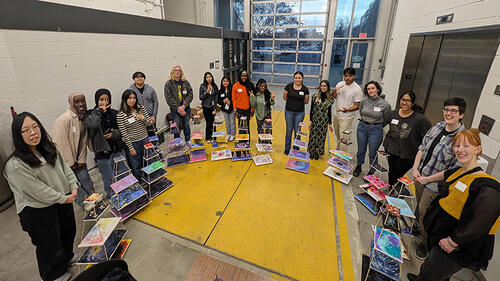
On December 9, fifteen local high school students from Yale Pathways to Science came to Yale Physics’ Wright Lab to participate in a unique intersection of art and physics.
Celín Hidalgo, Wright Lab DOE research trainee, led the students in a half day event where they created multi-tiered painted “clocks of time” that represented the history of the Universe in conversation with the history of art.
The program included five segments, which corresponded to five canvases that each participant painted with inspiration from five different scientific and artistic epochs under the direction of Hidalgo. After each segment was completed, the students presented their painting for that segment and explained their methods and ideas. Each student’s five canvases were then joined together as a whole at the end.
Hidalgo explained that the size of the canvases increased as the program progressed in order to teach the students about the expansion of the Universe. “From the Big Bang in the first canvas to the future in their last one, the universe is rapidly expanding,” Hidalgo said.
The participants were also paired up with Wright Lab graduate students during the event, including Claire Laffan, Emily Pottebaum, and Sierra Wilde. The graduate students and participants discussed topics such as applying to college, requirements of a physics major, and other sciences, such as chemistry while painting their clocks of time.
The segments were as follows:
-
Big Bang and Paleolithic Art: For the first, smallest canvas, Hidalgo explained how the Big Bang was a big cosmic explosion. She related it to how cave art was very dynamic, throwing colors at the walls, using hands; and usually had a predominantly red palette. The students then recreated a big explosion in their canvas, utilizing elements related to Paleolithic Art.
-
First Particles and Baroque Art: For the second canvas, Hidalgo explained how the beginning of the Universe was a cosmic soup just beginning to form and the universe was very dark and cold.The first particles came from this and Baroque art had a generally dark palette, with only a few bright tones.
-
First Atoms and Rococo: For the third canvas, Hidalgo explained how the previously discussed particles start to combine into atoms and form structures, and how the light in the Universe increased during this time. Rococo uses very soft strokes and round figures with a light palette.
-
Galaxies, Dark Matter, and Post-Impressionism: For the fourth canvas, Hidalgo explained how the atoms combine to create bigger celestial bodies such as galaxies, planets and stars. Post-Impressionism uses swirling patterns and bright colors.
-
The future of the Universe: Students were encouraged by Hidalgo to imagine what the Universe would look like in the future and be creative illustrating their ideas on their fifth, and biggest canvas.
Hidalgo’s inspiration for the “clocks of time” came from artist Rebecca Kamen.
Hidalgo said, “I wanted to create an event to demonstrate how the arts and sciences could go together. A way to introduce high school students to incredibly interesting fields in a visual way, with paintings, so they could have an introduction to the evolution of the universe and the history of art.” She continued, “It was also a way for the students to understand that they can belong in both science and art fields; that scientists have multiple interests and very fascinating research.”
This event was co-sponsored by Yale Pathways to Science and Wright Lab. The Yale Pathways to Science team assisted Hidalgo in organizing and running the event, and included program manager Maria Parente, program administrator Rick Crouse, and undergraduates Angel Martinez Acevedo, and Ellika Edelman. Special thanks go to Wright Lab research and development technician Frank Lopez who assisted in preparing and securing the space in the Wright Lab Vault for the event; and Wright Lab graduate student Molly Watts, who assisted in the planning of the event.
Photos from the event can be seen on our Flickr page here.
This story was adapted from the Wright Lab news story of December 14, 2023. See below for the link to the original story.